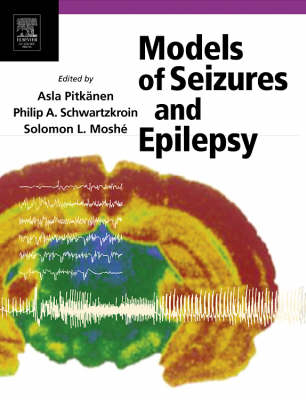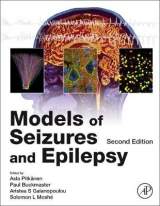
Models of Seizures and Epilepsy
Academic Press Inc (Verlag)
9780120885541 (ISBN)
- Titel erscheint in neuer Auflage
- Artikel merken
An understanding of mechanisms underlying seizure disorders depends critically on the insights provided by model systems. In particular with the development of cellular, molecular, and genetic investigative tools, there has been an explosion of basic epilepsy research. Models of Seizures and Epilepsy brings together, for the first time in 30 years, an overview of the most widely-used models of seizures and epilepsy.
Chapters cover a broad range of experimental approaches (from in vitro to whole animal preparations), a variety of epileptiform phenomenology (including burst discharges and seizures), and suggestions for model characterization and validation, such as electrographic, morphologic, pharmacologic, and behavioral features. Experts in the field provide not only technical reviews of these models but also conceptual critiques - commenting on the strengths and limitations of these models, their relationship to clinical phenomenology, and their value in developing a better understanding and treatments.
Models of Seizures and Epilepsy is a valuable, practical reference for investigators who are searching for the most appropriate laboratory models for addressing key questions in the field. It also provides an important background for physicians, fellows, and students, offering insight into the potential for advances in epilepsy research.
Dr. Pitkänen is currently a Professor of Neurobiology at the University of Eastern Finland in Kuopio, Finland. She has over a 30 years’ experience in working and developing animal models of acquired epilepsy and phenotyping of epilepsy models, using histologic and molecular analysis, behavioral tests, long-term video-EEG and MRI imaging. She is a leader in epilepsy research and has participated in several NINDS on Epilepsy Models Workshops and worked in several ILAE Committees related to preclinical modelling and use of models to develop better therapies for epilepsy. She has an h-index of 52 and has over 279 publications. Dr. Moshé is the is the Charles Frost Chair in Neurosurgery and Neurology and Professor of Neurology, Neuroscience, and Pediatrics at Albert Einstein College of Medicine. He is the Director of Child Neurology and Clinical Neurophysiology Dr. He has been President of the International League Against Epilepsy, American Epilepsy Society and American Clinical Neurophysiology Society (1996-1997). He is the recipient of several honors and awards, including Teacher-Investigator Development Award; Jacob Javits Neuroscience Investigator Award from NIH; Michael Prize for Achievement in Epilepsy Research; The American Epilepsy Society Research Award; Ambassador for Epilepsy Award from the International League Against Epilepsy; the Gloor Award from the American Clinical Neurophysiology Society; J.E. Purkyne Honorary Medal in Biomedical Research by the Czech Academy of Sciences; the 2008 Mentor of the Year Award from Albert Einstein College of Medicine; The 2010 Global and Awareness Award from Citizens United for Research in Epilepsy; the First Saul R. Korey Award in Translational Science and Medicine, Albert Einstein College of Medicine in 2012; elected Foreign Member of the Russian Academy of Sciences and Fellow of the American Epilepsy Society 2016. Since 1979, his research has focused on understanding the mechanisms underlying age-related differences in epilepsy in humans and in animal models.
Chapter 1: What Should Be Modeled?
A.: IN VITRO PREPARATIONS
Chapter 2: Single Nerve Cells Acutely Dissociated from Animal and Human Brains for Studies of Epilepsy
Chapter 3: Cell Culture Models for Studying Epilepsy
Chapter 4: An Overview of In Vitro Seizure Models in Acute and Organotypic Slices
Chapter 5: The Use of Brain Slice Cultures for the Study of Epilepsy
Chapter 6: Hippocampal Slices: Designing and Interpreting Studies in Epilepsy Research
Chapter 7: Thalamic, Thalamocortical, and Corticocortical Models of Epilepsy with an Emphasis on Absence Seizures
Chapter 8: Studying Epilepsy in the Human Brain In Vitro
Chapter 9: In Vitro Isolated Guinea Pig Brain
B.: INDUCED SEIZURES IN INTACT ANIMALS
Chapter 10: Pharmacologic Models of Generalized Absence Seizures in Rodents
Chapter 11: Models of Chemically-Induced Acute Seizures
Chapter 12: Electrical Stimulation-Induced Models of Seizures
Chapter 13: Alcohol Withdrawal Seizures
Chapter 14: Alumina Gel Injection Models of Epilepsy in Monkeys
C.: GENETIC MODELS
Chapter 15: Modeling Epilepsy and Seizures in Developing Zebrafish Larvae
Chapter 16: Transgenic and Gene Replacement Models of Epilepsy: Targeting Ion Channel and Neurotransmission Pathways in Mice
Chapter 17: Spontaneous Epileptic Mutations in the Mouse
Chapter 18: Genetic Models of Absence Epilepsy in the Rat
Chapter 19: Models with Spontaneous Seizures and Developmental Disruption of Genetic Etiology
Chapter 20: Mammalian Models of Genetic Epilepsy Characterized by Sensory-Evoked Seizures and Generalized Seizure Susceptibility
Chapter 21: Inherited Epilepsy in Mongolian Gerbils
D.: ACQUIRED FOCAL MODELS
Chapter 22: The Cortical Freeze Lesion Model
Chapter 23: MAM and Other “Lesion Models of Developmental Epilepsy
Chapter 24: In Utero Irradiation as a Model of Cortical Dysplasia
Chapter 25: Modeling Hypoxia-Induced Seizures and Hypoxic Encephalopathy in the Neonatal Period
Chapter 26: Complex Febrile Seizures—An Experimental Model in Immature Rodents
Chapter 27: Repetitive Seizures in the Immature Brain
Chapter 28: The Kindling Phenomenon
Chapter 29: Kindling Kittens and Cats
Chapter 30: Electrical Kindling in Developing Rats
Chapter 31: Chemical Kindling
Chapter 32: Kindling, Spontaneous Seizures, and the Consequences of Epilepsy: More Than a Model
Chapter 33: Tetanus Toxin Model of Focal Epilepsy
Chapter 34: Kainate-Induced Status Epilepticus: A Chronic Model of Acquired Epilepsy
Chapter 35: The Pilocarpine Model of Seizures
Chapter 36: Status Epilepticus: Electrical Stimulation Models
Chapter 37: Posttraumatic Epilepsy Induced by Lateral Fluid-Percussion Brain Injury in Rats
Chapter 38: Chronic Partial Cortical Isolation
Chapter 39: Head Trauma: Hemorrhage-Iron Deposition
Chapter 40: Stroke
Chapter 41: Models Available for Infection-Induced Seizures
Chapter 42: Brain Tumor and Epilepsy: A New Neurophysiologic and Neuropathologic Ex Vivo In Vitro Model
Chapter 43: An Animal Model of Rasmussen’s Encephalitis
E.: MODELS USED FOR PHARMACOLOGICAL ASSESSMENT
Chapter 44: Therapeutic Assays for the Identification and Characterization of Antiepileptic and Antiepileptogenic Drugs
Chapter 45: Animal Models of Drug-Refractory Epilepsy
F.: TECHNICAL APPROACHES FOR MODEL CHARACTERIZATION
Chapter 46: Monitoring for Seizures in Rodents
Chapter 47: Imaging Approaches in Small Animal Models
Chapter 48: Behavioral Characterization of Seizures in Rats
Chapter 49: Behavioral and Cognitive Testing Procedures in Animal Models of Epilepsy
Chapter 50: Morphologic Approaches to the Characterization of Epilepsy Models
G.: IMPORTANT QUESTIONS
Chapter 51: Animal Model Development Based on the Human Epilepsies: Which Causes and Syndromes Should Be Modeled?
Chapter 52: What Good Are Animal Models?
Index
| Erscheint lt. Verlag | 4.10.2005 |
|---|---|
| Verlagsort | San Diego |
| Sprache | englisch |
| Maße | 216 x 279 mm |
| Gewicht | 1880 g |
| Themenwelt | Medizin / Pharmazie ► Medizinische Fachgebiete ► Neurologie |
| ISBN-13 | 9780120885541 / 9780120885541 |
| Zustand | Neuware |
| Informationen gemäß Produktsicherheitsverordnung (GPSR) | |
| Haben Sie eine Frage zum Produkt? |
aus dem Bereich



